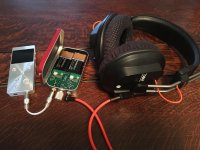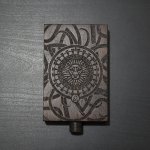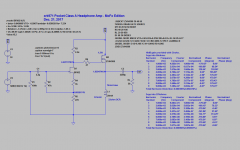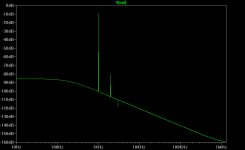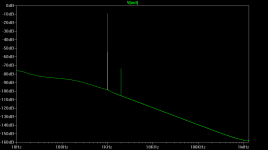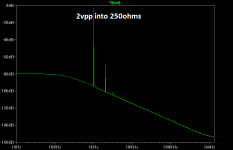The solder paste is solder particles in a carrier fluid of flux. It flows nicely and self-removes solder bridges via surface tension from each pad. Assuming you don’t apply too much paste I have never had a problem with bridging. Even if you start with bridged paste, it clean up after itself. Quite amazing and 100% success rate so far with many boards (40+).
Good to know. I enjoy making each joint by hand but if I have another failure I'll be firing up the hotplate...
BTW I couldn't resist nabbing a Cyber Monday deal, so I just bought my first set of planar headphones, the Mayflower 1, which is a modified version of the Fostex T50RP MkIII. They are notoriously hard to drive, but Funch said his Pocket Class A build made his fully custom T50RP-based cans sound the best he'd ever heard them... Will report back!
BTW I couldn't resist nabbing a Cyber Monday deal, so I just bought my first set of planar headphones, the Mayflower 1, which is a modified version of the Fostex T50RP MkIII. They are notoriously hard to drive, but Funch said his Pocket Class A build made his fully custom T50RP-based cans sound the best he'd ever heard them... Will report back!
Hi StellarE,

I hope those planar cans are not too low impedance. What are they rated at and what is sensitivity?
I have a customer from HeadFi who bought the NHB amp for the HD6xx and it works great for that. She just got a planar HE4XX from Massdrop (93dB and 30ohms) and reports that it is not a good match (and I predicted thus - distortion would be quite high).
However, I ran some sims and it seems if you use the OKcells 9v rechargeable LiPo’s, they will work much better due to the higher voltage (fixed at 9v with internal DC step up). The THD with EBL’s would be 0.12% for 99dB and with the OKCells, only 0.07% THD. I want to test this out. Does anyone have HiFiMan HE400’s?
I enjoy making each joint by hand
I hope those planar cans are not too low impedance. What are they rated at and what is sensitivity?
I have a customer from HeadFi who bought the NHB amp for the HD6xx and it works great for that. She just got a planar HE4XX from Massdrop (93dB and 30ohms) and reports that it is not a good match (and I predicted thus - distortion would be quite high).
However, I ran some sims and it seems if you use the OKcells 9v rechargeable LiPo’s, they will work much better due to the higher voltage (fixed at 9v with internal DC step up). The THD with EBL’s would be 0.12% for 99dB and with the OKCells, only 0.07% THD. I want to test this out. Does anyone have HiFiMan HE400’s?
The T50RP are rated at 50 Ohms. Sensitivity is only 92dB...maybe this is not looking so good for me. I almost got HD600 but wanted more bass. I have been talking with a guy on Head-Fi who has tried everything and now powers his T50RP with a 200wpc speaker amp...seems ludicrous to me but he swears it's the best he's heard them sound.
I am still using the OKCells. Eventually I will switch to the RaptorLightning LiPo setup, which would give me the option to boost voltage even higher, up to the limits of excess heat. I had no idea that driver sensitivity and THD were inversely related. I hope I can get an acceptable result.
I am still using the OKCells. Eventually I will switch to the RaptorLightning LiPo setup, which would give me the option to boost voltage even higher, up to the limits of excess heat. I had no idea that driver sensitivity and THD were inversely related. I hope I can get an acceptable result.
It should be ok with 18v battery voltage and not played too loudly.
Planars will work well with a beefy SE Class A with 1.2amp bias current. Like Sikicon Harmony or MoFo, etc. need to drive with the Aksa Lender pre to get sufficient voltage.
They are reputed to sound awesome once given enough power though.
Planars will work well with a beefy SE Class A with 1.2amp bias current. Like Sikicon Harmony or MoFo, etc. need to drive with the Aksa Lender pre to get sufficient voltage.
They are reputed to sound awesome once given enough power though.
Finished my first RaptorLightning cap multiplier today. Truly easy peasy as Juma's name for the circuit suggests.
The Raptor USB load sharing board, however, has proven to beyond the limits of my soldering skills and equipment. The micro USB jack is the only hard part. Those five pins are absolutely tiny and hardly protrude from the main jack body at all. I tacked the steel housing down first and then tried to quickly drag a hot drop of solder across the pins...and ended up with a huge bridge across ALL the pins AND the nearest part of the housing lol. I then cranked up the heat and sucked up most of the solder with a solder braid, but I lifted a pad in the process. I can do most SMT but apparently not all. Honestly, those pins are so tiny, I don't think I'd ever be able to visually tell if I got every pin soldered or not. Argh. There must be an easier way to get the two power leads out of a micro USB...?
Here's a pic of my one success today.
Flux. And just the right amount of solder. If you can bridge the heat to all the pins you're fine. Get just the right amount of solder in there with -tons- of flux and it will find the correct home. Bridging comes from either too much solder or not enough flux to carry the heat to the pads and remove the thin layer of surface oils/oxidation that cause it to not stick and flow.
Edit: I'd love to post a magnified video of what I'm talking about. I use water soluble flux which has about the same viscosity as water and basically "boil" the connections in a small pool when I solder them, in no way stingy or careful about application unless I solder things that shouldn't get too wet with flux (potentiometers, etc.). It is the best way I've found to get joints like my earlier pictures of the PCA board. Cleanup has to be absolutely thorough, especially with the water soluble flux. However, thorough isopropyl washings with a brush, followed by a good surfactant cleaner, water, and compressed air work great.
Last edited:
Raptor, your detailed description is very helpful and reflects perfectly the flux "magic" I observed in several videos. I'll "boil" the next one, lol.
In other news...yes my Pocket Class A drives my new Mayflower Fostex planars. In fact, I can keep the volume pot around noon unless I really want to rock out hard. Man, these things do realistic instrumental textures like I've never experienced from a headphone. Really awesome detail. I have never heard these cans powered by a beastly multi-watt desktop rig, so I have no point of reference to say if THD could be lower. What I can say is that they sound great with this amp biased at 64mA.
In other news...yes my Pocket Class A drives my new Mayflower Fostex planars. In fact, I can keep the volume pot around noon unless I really want to rock out hard. Man, these things do realistic instrumental textures like I've never experienced from a headphone. Really awesome detail. I have never heard these cans powered by a beastly multi-watt desktop rig, so I have no point of reference to say if THD could be lower. What I can say is that they sound great with this amp biased at 64mA.
Attachments
StellarE:
Nice to know it can drive the Fostex planars. I know it struggles with 30ohm 85dB HE400's. I see that you are using MELF resistors. Where did you get those as I was trying order for my Aksa Lender preamp and all the US distributors (Mouser, Digikey, Newark) are wiped out.
X
Nice to know it can drive the Fostex planars. I know it struggles with 30ohm 85dB HE400's. I see that you are using MELF resistors. Where did you get those as I was trying order for my Aksa Lender preamp and all the US distributors (Mouser, Digikey, Newark) are wiped out.
X
Built a custom box for a friend of mine
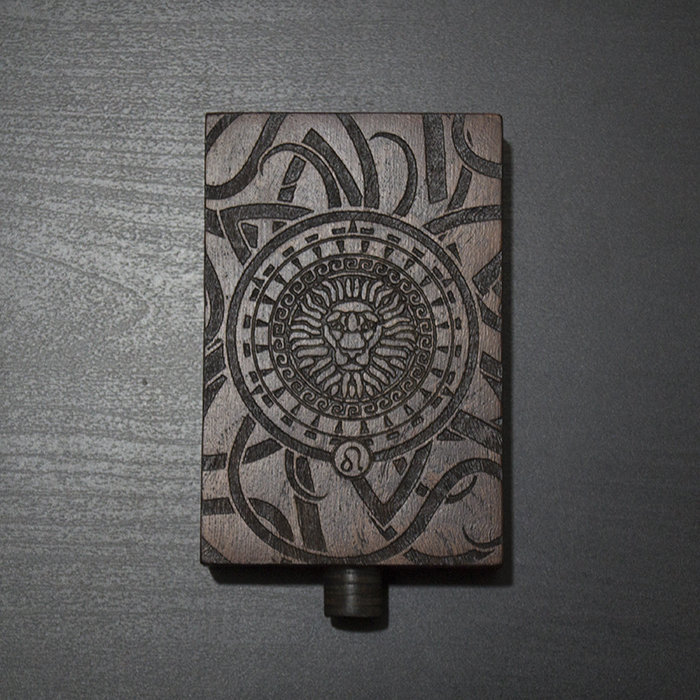
cheers
Wow! That is quite a beautiful case!
What size are yours? It could be that I am looking for the next size up and they seem to be wiped out of stock.
Oops, I lied. Turns out I sourced the MELF resistors from Mouser. I used the 0102 size in the PCA and they fit very well on the pads. Digikey does stock some MELF but it sounds like maybe not that size. I recently used a 0204 MELF from Digikey on my Cap Mx.
Just got some new gear in the mail and finally I feel adequately tooled up. Solder sucker, RMA flux pen, and a new set of iron tips. Today was the last day of school for the year here, and I am a teacher so I have a little break now.
Last edited:
Hi StellarE,
No worries - I just got a small set of MELFs sent to me from JPS64. Apparently they have plenty of stock in Germany. Those look tricky to work with - the color bands are hard to read, and they roll off the table or fly off the tweezers easily. Hence nicknamed Most End up Lying on the Floor.
Glad tools and supplies are in and school is out. Have fun - what’s next ?
@Aatto: that’s a beautiful case!
No worries - I just got a small set of MELFs sent to me from JPS64. Apparently they have plenty of stock in Germany. Those look tricky to work with - the color bands are hard to read, and they roll off the table or fly off the tweezers easily. Hence nicknamed Most End up Lying on the Floor.
Glad tools and supplies are in and school is out. Have fun - what’s next ?
@Aatto: that’s a beautiful case!

Over in the Pass Forum, MoFo thread, I am seeing ways to improve the performance of this Pocket Amp by adding a small hand-wound toroidal choke. It stores energy and releases it to allow higher output swing voltage and hence, lower distortion and improved dynamics. It's like getting more power for free.
The sim I have is for a 20mH choke made by winding small gauge magnet wire around a toroidal choke. You can even use commercially available ones and they could be even solid cylinder ferrite cores. The overall DC resistance needs to be 22ohms. If it is less, then add a resistor in series to get 22ohms DCR. It takes a slight adjustment of R3 supplying the drain of the JFET to get the bias setpoint correctly set. A pot here might be good to start, then convert to a fixed value.
Here are the simulations for several operating points. The 250ohm case is the easy one, but it shows that even at a 50ohm load, the distortion is still reasonable. This is preliminary so be careful with heat dissipation - the MOSFET is now at 1.2W which means a bigger heatsink is needed maybe the IRF610 with local heatsink may be better here. Note that output voltage could be as high as 2x Vcc so choose caps accordingly.
LTSpice Schematic/Model:
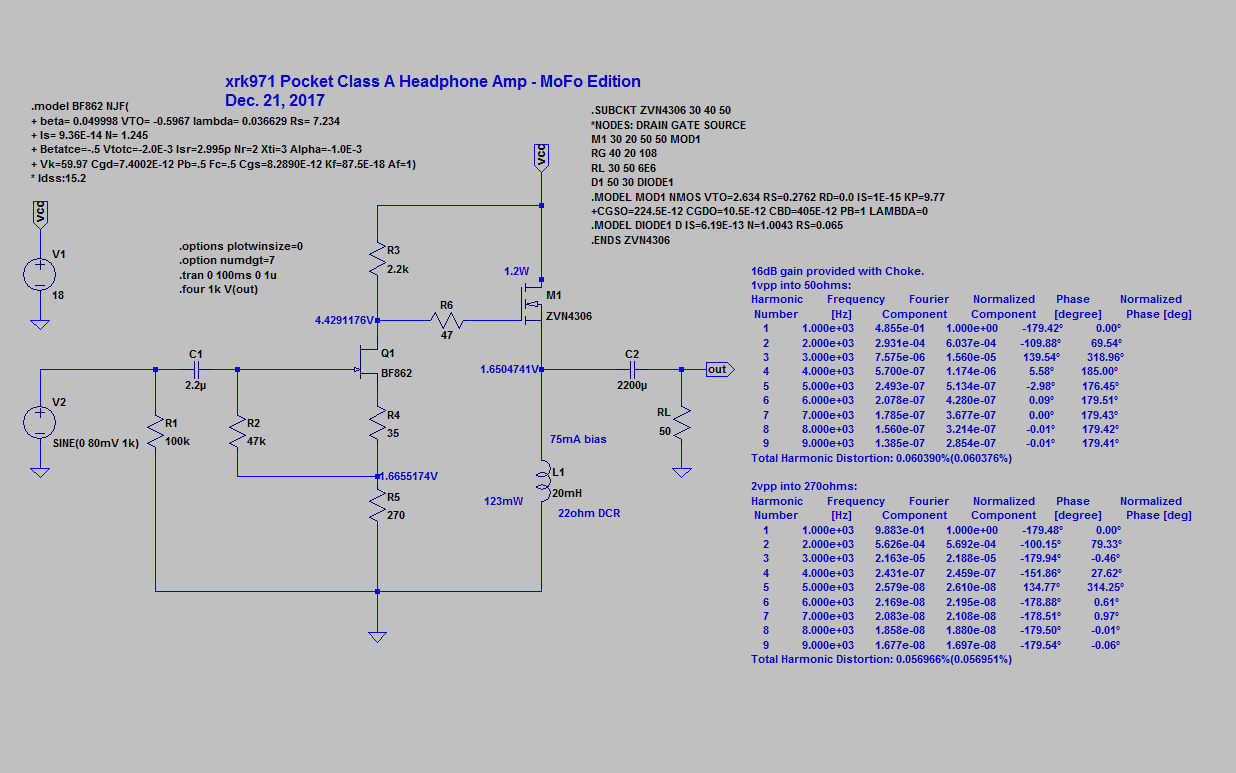
1Vpp into 250 ohms:
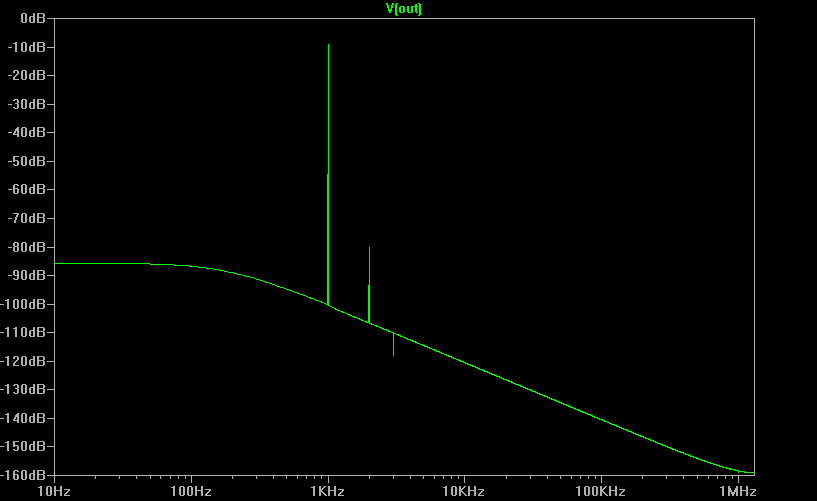
1Vpp into 50ohms note that THD is only 0.06% (these were about the same figures for the non choked version for 270ohm load):
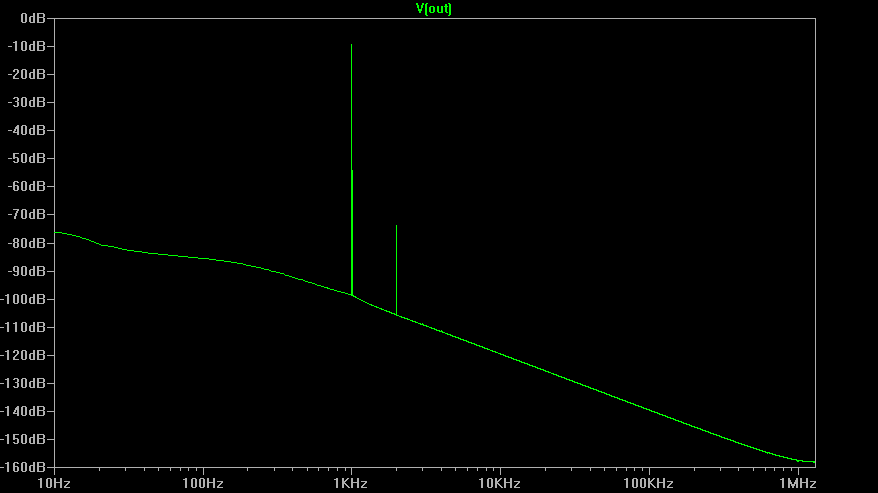
2Vpp into 250ohms:
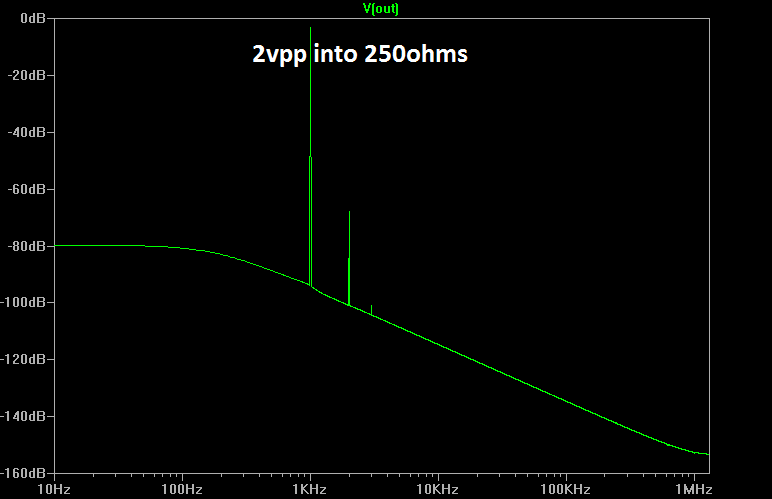
The sim I have is for a 20mH choke made by winding small gauge magnet wire around a toroidal choke. You can even use commercially available ones and they could be even solid cylinder ferrite cores. The overall DC resistance needs to be 22ohms. If it is less, then add a resistor in series to get 22ohms DCR. It takes a slight adjustment of R3 supplying the drain of the JFET to get the bias setpoint correctly set. A pot here might be good to start, then convert to a fixed value.
Here are the simulations for several operating points. The 250ohm case is the easy one, but it shows that even at a 50ohm load, the distortion is still reasonable. This is preliminary so be careful with heat dissipation - the MOSFET is now at 1.2W which means a bigger heatsink is needed maybe the IRF610 with local heatsink may be better here. Note that output voltage could be as high as 2x Vcc so choose caps accordingly.
LTSpice Schematic/Model:
1Vpp into 250 ohms:
1Vpp into 50ohms note that THD is only 0.06% (these were about the same figures for the non choked version for 270ohm load):
2Vpp into 250ohms:
Attachments
Last edited:
Over in the Pass Forum, MoFo thread, I am seeing ways to improve the performance of this Pocket Amp by adding a small hand-wound toroidal choke. It stores energy and releases it to allow higher output swing voltage and hence, lower distortion and improved dynamics. It's like getting more power for free.
The sim I have is for a 20mH choke made by winding small gauge magnet wire around a toroidal choke. You can even use commercially available ones and they could be even solid cylinder ferrite cores. The overall DC resistance needs to be 22ohms. If it is less, then add a resistor in series to get 22ohms DCR.
Here is the simulations for several operating points. The 250ohm case is the easy one, but it shows that even at a 50ohm load, the distortion is still reasonable.
I will have to try this when I get around to building my desktop version.
I've just ordered the PCB and FETs and would like to know if there is a recommended BOM. I have an AKG K500 for at home and a Beyerdynamic DT770 80Ohm version. Do I need to tune it accordingly or can I use both with the same parts?
Here is the latest BOM that should be able to work with your low impedance headphones. It uses the 2200uF Nichicon KA output caps. Install the 1uF Wima bypass on the SMT side. On inputs, use just the 10uF Silmic II. Tuning for low impedance cans involves adjusting R4 to get a slightly higher bias (circa 65mA to 70mA as measured through R7). Usually a 47R or 51R value gives higher bias. However, it is at the expense of higher 3rd order HD relative to 2nd order. The other way to do it is to choose 'hot' (higher Idss JFETs). The ones I sent you should work well with a 47R value for R4. If it is too high, add a high value like 220R in parallel to lower it slightly.
Attachments
Last edited:
- Home
- Group Buys
- xrk971 Pocket Class A Headamp GB
